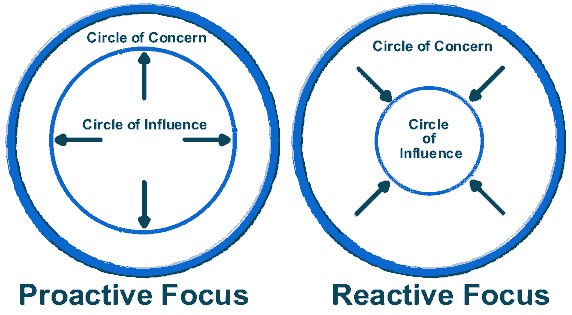
The chief task in life is simply this: to identify and separate matters so that I can say clearly to myself which are externals not under my control, and which have to do with the choices I actually control … Not to uncontrollable externals, but within myself to the choices that are my own… – Epictetus, Discourses
Lately, I have found myself revisiting many of Stephen Covey’s tools in 7 Habits For Highly Effective People, namely the Circle of Influence and Control Model. I think the reason it is making a resurgence in my conversations with leaders is that as leadership roles expand seemingly rapidly, often leaders are left feeling an underlying sense of being out of control even though their sphere of responsibility is exponentially larger. Why? The answer lies in what we can control versus what we can influence as leaders. Covey’s tool is the best I have encountered because in its simplicity it is impossible to forget and has the power to shift leader orientation proactively for years after it is learned.
Covey’s model is focused on two spheres:
- The Circle of Concern – the wide range of concerns we might have about topics like the weather, the economy, the pandemic, or war that are largely out of our control.
- The Circle of Influence – a narrowing of the first circle into those concerns we can do something about – either directly or indirectly

We are reactive when we focus on the concerns outside our influence. We risk increasing our stress and falling into the space of accusing, blaming, and victimization and our circle of influence shrinks in relationship to our reactive response.
By choosing to focus on the circle of control and influence – we move into a more proactive space. Rather than spending energy on things we can do nothing about, we can take steps that make a positive difference calling on our strengths and connections. We can also choose to let go of concerns that are not serving us well.
The tool itself shows us a way to explore how to gain control when we feel like we have none in order to discover that we always have more power than we think.
Let’s Practice:
By determining which of these two circles is the focus of most of our time and energy, we can discover much about our degree of proactivity. It is important to start with ourselves as leaders, but the process can then be expanded effectively at the team level.
Are you ready?
Materials: Post-it notes, markers, and flipchart paper or poster board.
- Draw two Concentric circles on a big sheet of paper. Label the outer circle Concern and the inner circle influence.
- Write a current complex situation you are facing as a leader across the top of the page.
- Using one post-it note for each item, brainstorm all the pain points, major initiatives, and key stakeholders that are instrumental to the success of the project.
Now, without overthinking placement:
- Put the notes in the outer Circle of Concern if you feel you have little or no control over these facets of the project but you care about them and spend time trying to address them.
- Put notes in the inner Circle of Influence if you feel the items represented are within your control or sphere of influence and are actionable from your current vantage point.
- If there is anything represented on a post-it note that can be eliminated from the project as something you can let go of completely, put it outside both circles.
Step back and look at how your circles are weighted. What does the current situation tell you about how proactive or reactive you are as a leader in relationship to this project? Jot some notes in the space below…
How can we move things from the outer circle to the inner circle? Here are some questions to prompt change:
- What is it that you could do to influence this? You may not be able to bring this item entirely under your control but you are looking for something that can be done. Spend time on this because there is a lot of room for movement from concern to influence if we focus on what can be done versus what can’t.
- If a piece of a post-it can be moved, rewrite the piece that can move and move it. When you think you have reflected on everything in the outer circle, ask yourself or a trusted person in your life, what else can I do to move the needle on the things that concern me?
- Leave things we truly can’t influence in the circle of concern and let them go for now. Accepting what we can’t influence is liberating, freeing up energy to focus on what we can influence. It’s an important part of the benefit people get from using this tool.
- Shifting our energy away from the Circle of Concern and into the Circle of Influence is the most important shift in energy from reactive to proactive. This is where the magic happens. What we can influence expands and the Circle of Concern shrinks!
Now what?
To draw the exercise to a close let’s commit to at least one action we can take today to increase our influence over the things we are concerned about and write it in the space below.
Continue to revisit this exercise and the movement of the post-it notes into our realm of influence as often as needed to become more and more proactive as a leader.
We need to focus our energy on those things that we can influence in order to be effective agents of change. If we do this over time we will find our circle of influence growing in diameter as others will see our effectiveness increasing our sense of personal power. Conversely, if all our energy goes into those things we cannot change our circle of influence will shrink. Not only will we drain our energy, but other people may also start to see us as overly negative and critical.
Knowing how far our circle of influence extends is an important aspect of emotional intelligence. Forming partnerships and alliances is equally important as we may not have any direct influence over something in our Circle of Concern, but we may know other people who do. A team can have a wider circle of influence than an individual. So reactive people find their circle of influence shrinks, while proactive people find that it increases.
The following quote by Viktor Frankl reminded me of the opening words above by Epictetus, “Forces beyond your control can take away everything you possess except one thing, your freedom to choose how to respond to the situation.”
Contact me if you would like to receive the above exercise in handout form or if you would like to discuss a team design for the using the Circle of Control and Influence.
Leave a Reply